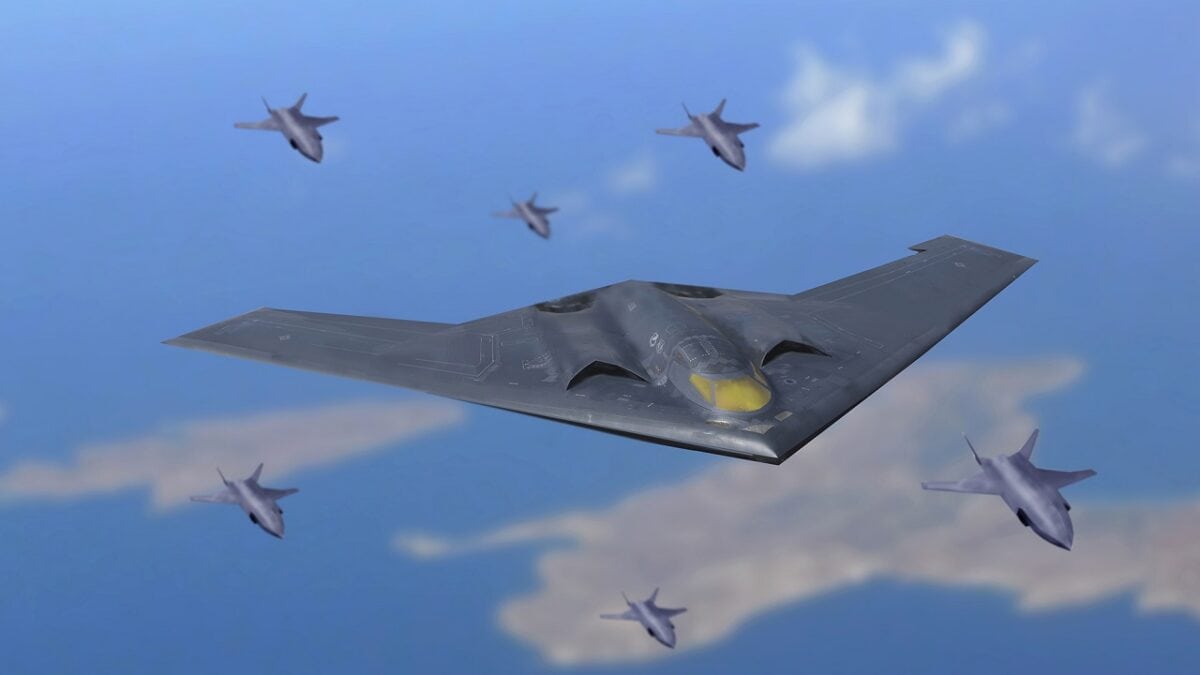Should drones escort the B-21 Raider? The U.S. Air Force’s next-generation bomber should make its first public appearance this year, and take its first flight in 2023. The drone concept envisions the B-21 acting as a quarterback of sorts, guiding what are called “collaborative combat aircraft.” However, the concept could add costs to a program that, until now, has mostly remained on time and under budget.
The Future of Long-Range Bombers
The primary mission for the B-21 is to maintain the long-range precision-strike leg of the nuclear triad. The Air Force believes it is time to move forward from the B-52 Stratofortress, the B-1B Lancer, and the B-2 Spirit that have served for decades.
Drones would be a nice addition for improving situational awareness, targeting, and bomb damage assessment. If the drones could run interference and conduct early warning chores, all while executing electronic warfare, the concept could make a B-21 mission more survivable and successful.
But it seems like Air Force Secretary Frank Kendall has moved on from the drone idea, citing its cost above all. Collaborative combat aircraft could still play a smaller role alongside the B-21, especially if they have a less ambitious mission. The B-21, after all, is designed to be a family of systems, and drones would make sense in this construct.
Proponents of unmanned escorts believe that a combat group of aircraft would force the enemy to use more anti-aircraft missiles and fighter jets to counter a strike mission from a B-21. Fifth-generation fighters might not have the range to accompany B-21s for bombing runs against China, so long-range drones could be the best option to help the bombers penetrate contested air space.
The drones could be untethered from the B-21, “taking off from closer in and capable of linking up with—and peeling off from—the manned platform,” said Caitlin Lee, senior fellow for the Mitchell Institute’s Center for Unmanned and Autonomous Systems, in an interview with Air Force Magazine.
Top Priorities for the B-21
Whether drones are used or not, the Air Force needs the B-21, according to Cynthia Cook, who is director of the Defense-Industrial Initiatives Group and a senior fellow of the International Security Program at CSIS.
“The B-2 stealth bomber was introduced 25 years ago. U.S. investments in new technologies create opportunities, and the investments of potential adversaries create new challenges. A new penetrating bomber will sustain the capability of the Air Force to strike across the globe,” Cook told 1945.

An artist illustration depicts a U.S. Air Force extended-range B-21 Raider escorted on a mission by armed unmanned next generation air dominance platforms. This fictional bomber features longer, wider wings, and a deeper fuselage that accommodates larger fuel tanks and dual weapons bays that enables the bomber to carry a much larger and varied payload. Mike Tsukamoto/staff; Greg Davis/USAF
Cook emphasized that the B-21 would be critical in a conflict in the Indo-Pacific, adding that the F-35 may not have the range to make it all the way to targets in China. “Distances in the Indo-Pacific region are enormous, and potential adversaries are investing in defensive systems,” she said. “Penetrating bombers with stealth technology are more likely to be able to penetrate adversary airspace and thus get closer to the fight than other manned aircraft. The B-21 has longer range than other modern manned stealth systems, such as the F-35, and certainly carries more munitions.”
Whether to use drones with the B-21 is ultimately up to the Air Force secretary and the U.S. Congress, which may balk at the extra cost. But it seems the B-21 will have the range and stealth capability to make a successful bombing run in the Indo-Pacific – these are its most important attributes. The unmanned piece could be integrated in later years, after the airplane enters serial production.
Expert Biography: Serving as 1945’s Defense and National Security Editor, Dr. Brent M. Eastwood is the author of Humans, Machines, and Data: Future Trends in Warfare. He is an Emerging Threats expert and former U.S. Army Infantry officer. You can follow him on Twitter @BMEastwood. He holds a Ph.D. in Political Science and Foreign Policy/ International Relations.

